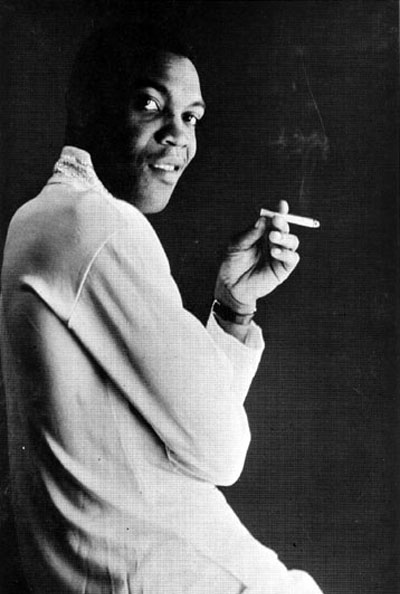
Facsimile Magazine, Published by Haoyan of America. Volume Three, Number Two, 2009. ISSN 1937-2116.
Facsimile Feburary 2009 ~ All Bailed Out
Table of Contents

Facsimile Magazine, Published by Haoyan of America. Volume Three, Number Two, 2009. ISSN 1937-2116.
Table of Contents
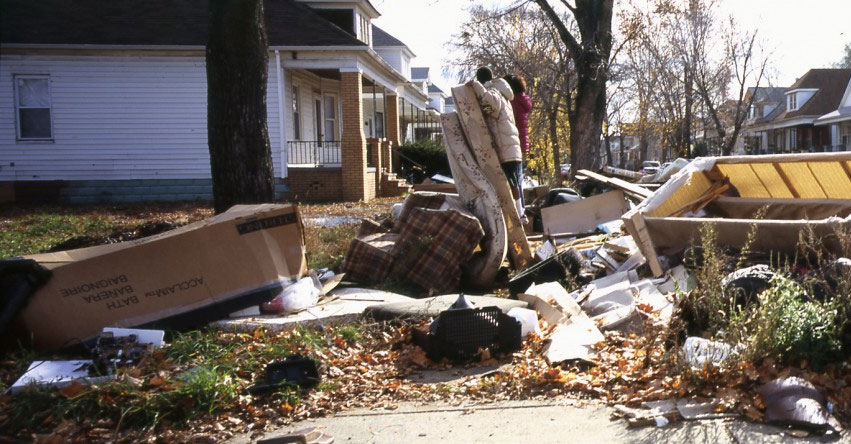
Children playing on garbage in front of the Power House in Detroit, Michigan.
By Michael Wines, From IHT, August 9, 2005

Smiling Ethiopian boy eating Plumpy'nut. Photo by Julie Pudlowski
In the crowd of riotously dressed mothers clasping wailing, naked infants at a Médecins Sans Frontières feeding center just west of here, Taorey Asama, at 27 months old, stands out for a heart-rending reason: She looks like a normal baby.
Many of the others have the skeletal frames and baggy skin of children with severe malnutrition. The good news is that a month ago, so did Taorey.
"When she came here, she was all small and curled up," said her mother, Henda, 30. "It's Plumpy'nut that's made her like this. She's immense!"
Never heard of Plumpy'nut? Come to Maradi, a bustling crossroads where the number of malnourished children exceeds even the flocks of motor scooters flitting down its dirt streets. At this epicenter of Niger's latest hunger crisis, Plumpy'nut is saving lives.
Plumpy'nut, which comes in a silvery foil package the size of two grasping baby-size hands, is 500 calories of fortified peanut butter, a beige paste about as thick as mashed potatoes and stuffed with milk, vitamins and minerals.
Since the packets came into the hands of relief organizations during the Darfur crisis in Sudan, they have been revolutionizing emergency care for severely malnourished children who are old enough to take solid food by taking care out of crowded field hospitals and straight into mothers' homes.
The prescription given mothers here is simple: Give one baby two packets of Plumpy'nut each day. Watch him wolf them down. Wait for him to grow. Which he will, almost immediately: By eating Plumpy'nut, badly malnourished babies can each week gain one to two pounds, or roughly 454 grams to 907 grams.
Milton Tectonidis, a nutrition specialist for Médecins Sans Frontières, said this about Plumpy'nut in an interview here: "This product, it's beyond opinion; it's documented; it's scientific fact. We've seen it working. With this one product, we can treat three-quarters of children on an outpatient basis."
Traditional malnutrition therapy hospitalizes children, nursing them to health with steady infusions of vitamin-laced milk. Then they are sent home with powdered milk formula to complete their recovery. It works well, but milk is costly, must be mixed with water and is prone to spoil. And when mothers prepare the formula with the dirty water all too common in impoverished villages, babies get sick. In comparison, Plumpy'nut - the name melds the words "plump" and "peanut" - costs less than the milk formula, has a two-year shelf life and need not be mixed with anything.
Perhaps most revolutionary is that mothers, not doctors, can give it to their toddlers. That not only reduces costs but also frees the doctors to attend to the sickest children, who often suffer from malnutrition as well as diseases like malaria or dysentery. The usual course of treatment is four weeks of Plumpy'nut, costing about $20, along with grain-based food like Unimix, a vitamin-packed flour that can be made into the porridge many Africans eat. But some children return to health in as little as two weeks.
The product is the brainchild of a French scientist, André Briend, who had labored in vain for years to concoct a ready-to-eat nutrition supplement until serendipity - a bottle of the popular breakfast spread Nutella on his kitchen table - led him to try a paste instead of candy bars and other forms of food. Later a French company that specializes in making food supplements for relief work, Nutriset, began packaging the formula under the name Plumpy'nut.
For three months, Médecins Sans Frontières, or Doctors Without Borders, has been handing out weeklong supplies of Plumpy'nut, 14 foil packets in a black plastic grocery sack, at its five outpatient feeding centers in Maradi and 21 centers elsewhere in Niger. Newcomer babies are weighed and measured, and only those whose weight is sharply below normal for their height qualify. Those who are too ill for outpatient care go to a nearby field hospital.
About 700 babies are being treated in Maradi, and about 130 more arrive for screening each day, of which perhaps 80 are accepted and given an ankle bracelet - their ticket, so to speak, for a weekly trip to the center for more foil packs, bags of grain and cooking oil.
Across the area of hunger in Niger, about 5,000 children spread across 32 feeding centers are being given the packets. Theodore Bitangi, the 33-year-old nurse who oversees the Maradi centers, says the program is growing almost as rapidly as its patients. "When they come in, the state they're in, they look like embryos, they're so small sometimes," he said. "And after taking Plumpy'nut, they look like real babies."
Mothers who have been feeding the paste to their babies would hardly disagree. "As soon as I got him home, he started eating it - every day, aggressively," Idrissa, 24, who has no last name, said of her 2-year-old son. "And after three days, I could see a big difference. The change was abrupt."
The son, who refused to open his eyes before starting the diet regimen a week earlier, has added fat under his sagging skin and cries when his packet is finished for another. "I don't know how to express it," Idrissa said. "I'm so happy."
Raham, 45, who also has no last name, walks an hour each way to the clinic from her village, Madata, to pick up a weekly bag of Plumpy'nut for her year-old son, Safia Ibrahim. "It's no problem to walk that far," she said, "because it's for the health of my baby."
One of its virtues is that Plumpy'nut can be made almost anywhere with local materials and a slurry of vitamins and minerals prepared by Nutriset.
Versions of the same product are being manufactured in Malawi and in Niamey, Niger's capital, and Nutriset has welcomed the notion of local partners - from charities to women's groups - who might make Plumpy'nut under license or even as franchisees.
Which raises a question: If Plumpy'nut is good enough to give malnourished children in food emergencies, why not give it to the countless thousands of children in Niger who are hungry when the world's attention is directed elsewhere?
The United Nations reports that 150,000 children under age 5 in Niger are severely malnourished, and an additional 650,000 moderately malnourished: all together, about one in five youngsters. Malnutrition is implicated in 60 percent of deaths of children younger than 5 - and in Niger, more than a quarter of all children never reach their fifth birthday.
This is another way to think of the math: 150,000 children times 14 packets a week times four weeks, is a lot of Plumpy'nut. But then, said Tectonidis, the nutrition specialist, it is not the mathematics, or even the nutrition science, that is the hard part. It is keeping the world's eyes focused on solving Niger's everyday hunger problem once the television coverage of this crisis has ended.
"We know what's needed in terms of malnutrition," he said. "It's just the will that's lacking."
By Rachel Higgins
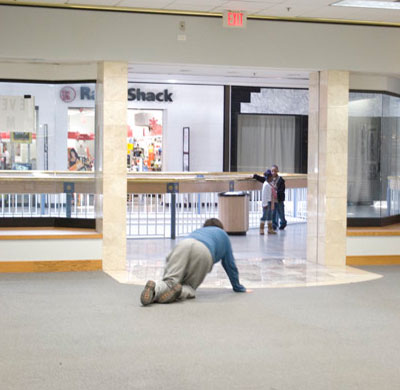
Rodney Hasty at Century Plaza.
One retail store leased in Century Plaza Shopping Mall in Birmingham, Alabama is the site of Everything Must Go, a temporary exhibition space featuring the work of twenty young artists from across the country. The exhibition will change each day over two weeks to feature a different artist or collaborative group.
In an American landscape full of abandoned malls, Everything Must Go is an attempt, not to revitalize these structures, but to embrace the playful fantasy that the empty mall offers as a social space.
Century Plaza Shopping Mall currently has 30 open stores and over 60 vacant stores. With a total leasable area of 750,000 square feet, less than a fourth is being used. Thousands of similar dead or dying malls can be found throughout America. Meanwhile, new shopping centers continue to be developed, sprawling farther and farther from city centers, where newer facades can be constructed , spent, and discarded. The greater Birmingham area has at least 7 major shopping centers, with more on the way. If the shopping center is the model around which our communities are built, what does the abandoned mall say about our society? America currently has more than four-thousand abandoned malls, more shopping centers than high schools, and twenty square feet of retail space for every person.
Using the conception of the artist as a scavenger within the contemporary landscape, we seek to re-claim these abandoned spaces--to simultaneously draw attention to their existence and offer alternative realities. Everything Must Go confronts the fantasy of the mall as a post-apocalyptic playground in the ruins of late-capitalism. This project pays homage to the dual sense of alienation and ambition inherent in the renegade communities so often depicted in horror movies, embraced in basement rock shows, or imagined within the escapist games of our youth.

Artists featured in this exhibition utilize the theatrical setting of the failed store to accentuate the void rather than filling it. Using the mall as a stage, these artists create situational works which engage viewers using sound, sculpture, video, collage, installation, and performance. The temporary nature of this exhibit offers a variety of voices within limited means, but also creates an impermanent, shifting dialogue. The project will be documented in a small series of publications available onsite and through a website which will be updated daily throughout the run of the exhibition.
Everything Must Go is created and produced by Rachel Higgins. Artists featured were selected from an open call to the artist’s immediate community of friends and colleagues working in New York, Philadelphia, and Birmingham. While proposals have been selected based on relevancy of subject matter and a familiarity with the artists' work, it is intended for the individual voice of each artist to own the space for a day.
Find out more about Everything Must Go at rachelhiggins.com.
By Michael Belknap, From U.S. Camera Annual '72
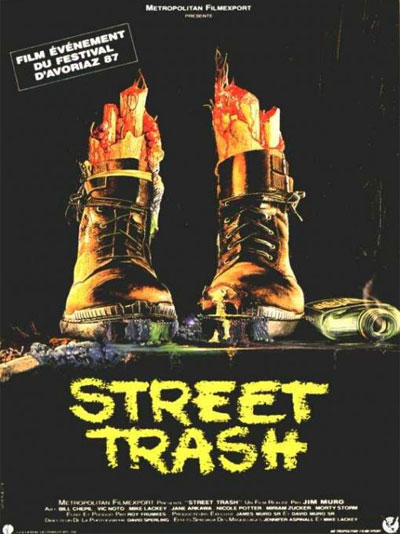
Movie poster for Street Trash.
The "American Way of Life" has been generous to many of us. We are a nation where two car families - with washing machines, toasters and electric stoves - are commonplace. Many Americans have all the conveniences a modern affluent society wants - but at great environmental costs.
As a result of our own excesses and our failure to pay the costs as they arise, our streets, our rivers and our air have been deteriorating at a quickening pace for decades with a resulting adverse impact on our health and wealth. Yet, despite the severity of the environmental crisis, many of us remain unmoved.
Pollution is very democratic; it attacks everyone - rich and poor.
Although proof of the cause-and-effect of pollutants and disease is not established, evidence shows loss of hearing, lung disease and poisonings as a result of pollution.
In addition to health considerations, we spend billions of dollars annually to clean up our waste and to restore our despoiled environment.
Make no mistake - the environmental issue is nothing shallow, rather but a deep and serious challenge to much of contemporary life. For our own benefit, we must change our attitudes and habits. And we can start a better American Way of Life.
By Mary Andrews Lewis
So Kim, I get a letter in the mail (please see below) with, guess what wrapped up inside? My driver's license!!! Didn't I throw that away in Philly over a year ago? I sure am glad I didn't "know" that ladies [sic] husband. Anyway, thanks for going through all that garbage with me.
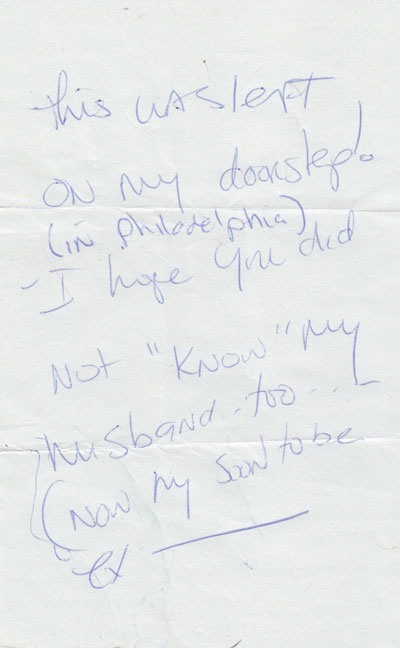
By Frisbee Zackson

Open classroom, Bronx school. Photo by Arthur Schatz
I was never the line leader in elementary school. The spot was always reserved for Emily Abbot or, whenever she was absent, Brian Bearfield. Never Frisbee Zackson. The reason was not because I was a troublemaker, nor because Emily and Brian were superior at their kindergarten studies. The coveted position was decided solely by where our last names fell in the alphabet—my teacher's standard method of selection.
The injustice of alphabetical order grieved me and permeated virtually all my school life. I was always given last choice on cubby holes, and therefore stuck with one on the top row. This made retrieving my 64-pack of Crayola's (with the built-in sharpener) tough even on tippy toes. In high school, all of the nice textbooks were selected before I had my pick. The leftovers often had loose pages and duct-taped covers; it really was a marvel of physics that my Physics book didn't completely disintegrate.
Just recently, I discovered that alphabetic discrimination exists beyond the realm of my schooling woes. A 2008 study by Daniel E. Ho and Kosuke Imai of Princeton University found that in primary elections, political candidates listed first on the ballot can double their percentage points simply because they are blessed alphabetically. Perhaps Hester Prynne's scarlet "A" would be worse if it were a "Z."
Back in my kindergarten class, I finally scrounged up the courage to confront my teacher before we assembled in the hall.
"Can you draw our names out of a hat for line leader?" I suggested politely. "Under the current system Emily and Brian receive preferential treatment for an arbitrary reason." (I was a very precocious kindergartner.)
"I suppose it's only fair," Mrs. Littleton said with a smile. Much to my delight, she then instructed us to write our names on slips of paper. As soon as all the names were collected into a snowman jar in the front of her desk, she reached in for a name. I desperately hoped the honor of line leader would finally be bestowed upon me.
"Ellen Singh," she called. Ellen, a shy girl, stood up feebly, but I could see she was beaming. And the joy quickly spread to me. Finally, the alphabetic monarchy had been overthrown, and democracy tasted sweet.
Encouraged by my early victory, I continue to seek justice and equality—except rather than slips bedecked in crayon, my quest manifests itself in different ways. In the contemporary world, it seems people have grown accustomed to inequities, but complacency is treacherous in an era of new challenges. People must become increasingly active, holding their leaders and themselves accountable. Call me naïve—I am young and idealistic—but I genuinely believe that I can make a difference in this world, whether it be via public policy reform, academia, non-profit work, or wherever life takes me. I have so many plans for this world, and I intend on seeing them through.
All things considered, life at the end of the twenty-six has taught me a great deal—I've even come to embrace it. The "Z" is pretty fun to write in cursive, and being called last in roll means I have more precious seconds at my locker before class. And if I were on someone's hit list, I'd probably be last. Most importantly, I've learned that people, even when they're at the bottom, can face up to challenges. Injustice never has to be the status quo.
By Dennis Kucinich, September 23, 2008
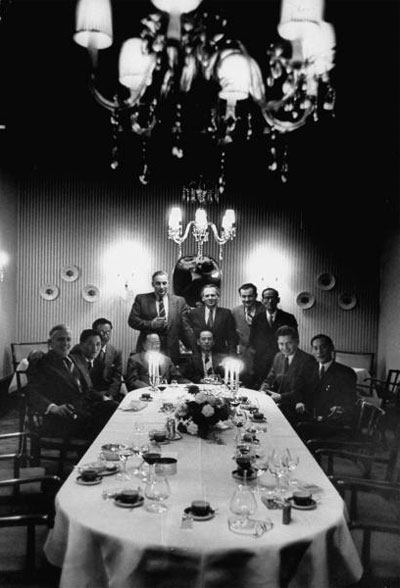
Smiling businessmen posing around banquet table. Photo by Ralph Crane
The U.S. government has been turned into an engine that accelerates the wealth upwards into the hands of a few. The Wall Street bailout, the Iraq War, military spending, tax cuts to the rich, and a for-profit health care system are all about the acceleration of wealth upwards. And now, the American people are about to pay the price of the collapse of the $513 trillion Ponzi scheme of derivatives. Yes, that's half a quadrillion dollars. Our first trillion dollar compression bandage will hardly stem the hemorrhaging of an unsustainable Ponzi scheme built on debt "de-leverages."
Does anyone seriously think that our public and private debts of some $45 trillion will be paid? That the administration's growth of the federal debt from $5.6 trillion to $9.8 trillion while borrowing another trillion dollars from Social Security has nothing to do with this? Does anyone not see that when we spend nearly $16,000 for every family of four in our society for the military each year that we are heading over the cliff?
This is a debt crisis, not a credit crisis. Just as FDR had to save capitalism after Wall Street excesses, we have to re-invigorate our economy with real - not imaginary - growth. It does not address the never-ending war on the middle class.
The same corporate interests that profited from the closing of U.S. factories, the movement of millions of jobs out of America, the off-shoring of profits, the out-sourcing of workers, the crushing of pension funds, the knocking down of wages, the cancellation of health care benefits, the sub-prime lending are now rushing to Washington to get money to protect themselves.
The double standard is stunning: their profits are their profits, but their losses are our losses.
This bailout will not bring real jobs back to America. It will not bring back jobs that make things. It does not rebuild our schools, streets, neighborhoods, parks or bridges. The major product of this financial economy is now debt. Industrial capitalism has been destroyed.
In the next few days I will push for a plan that includes equity for every American in any taxpayer investment in this so-called bail-out plan. Since the bailout will cost each and every American about $2,300, I have proposed the creation of a United States Mutual Trust Fund, which will take control of $700 billion in stock assets, convert those assets to shares, and distribute $2,300 worth of shares to new individual savings accounts in the name of each and every American.
I will also insist that all of the following issues be considered in whatever Congress passes:
And, most importantly, some mechanism for direct assistance to homeowners saddled with unreasonable or unmanageable mortgages, as well as protection for renters who have lived up to their obligation but fall victim to financial tragedy when the property they live in undergoes foreclosure.
These are just some thoughts on the run. You will hear more from me tomorrow.
By Marc H. Miller, From the East Village Eye, Feburary, 1983

Forbes Magazine cartoon by Edwin Marcus.
If it won't trickle down, will it tumble down? That's the million-dollar question raised by this month's Memorabilia. This January 1929 Forbes Magazine cartoon by Edwin Marcus shows the frenzied optimism on Wall Street a scant nine month before the disastrous October crash. Now once again the bulls are raging. The volume of shares at the Stock Exchange is up and the value of the Dow Jones Industrials (Exxon, General Motors, U.S. Steel and 27 other goodies) has skyrocketed to unprecedented heights. But will this boom go bust? Ex-Yippie and former stock consultant Jerry Rubin, for example wants nothing more to do with Wall Street. Instead he teaches courses on promotion and entrepreneurship at the Annes. Rather than throw money at the stock market, he's found rallies at Studio 54 to be more lucrative. But then there's that old bear Joe Granville. His famous "sell everything" bulletin in January 1981 caused the Dow to plunge amidst a mini-panic and now he's predicted a Depression in '83. "Mark my words," he says, "Ronald Reagan will go down in history as the Herbert Hoover of his generation." Is this Chicken Little mistaking a ticker tap parade for the falling sky? Stay tuned. (And remember: Buy low, sell high!)
By Gina Reichert & Mitch Cope

Repainted exterior of the Power House.
The Power House Project is first and foremost designed to stimulate communication, excitement and action within an otherwise challenging, albeit unique Detroit neighborhood. By way of mining out the positive and productive aspects of the neighborhood and by becoming a space where people can feel comfortable to share ideas, knowledge and expertise about the fundamentals of neighborhood living (gardening, house work, new technologies, safety, etc.) Power House serves a dual purpose: to produce, educate and sustain the best aspects of the Detroit neighborhood while at the same time providing a location for visitors to interact with the neighbors and vise-versa, specifically artists and musicians. Power House is a magnet for gathering resources, energy, social ideas and change.
The first Power House structure is a foreclosed two bedroom working class house, typical in Detroit. Rather than view this as a drain on the tax base, bank holdings, and local economics of lowered property values, Power House flips this notion of financial strain into a community asset. It seeks to create a network of mini-power stations from vacant properties by outfitting houses with 'green' energy sources - wind, solar, biomass - thus creating localized networks of sustainable power along with a stronger sense of space and empowerment.
Every Power House would be capable of producing enough energy for itself and having enough excess power left over for at least one neighboring home. This is feasible due to the extremely low cost of purchasing property and the amount of vacant small single family homes in Detroit. A certain percentage of each Power House would also function as neighborhood hubs by not only providing electricity but also a new point of identity, gathering place of creative exchange, thus a new type of neighborhood where undesirable homes become experimental factories for community action and power.
Find out more about the Power House Project at powerhouseproject.com.
By Nick Lucking and Tim Ivison
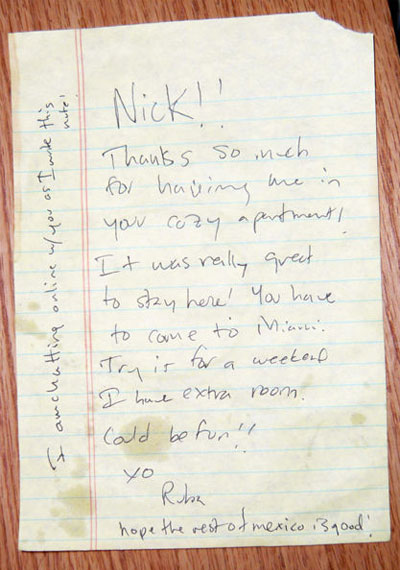
Note for Nick from Ruba Katrib at Berkeley St. Residency.
The program objective of spcmkr.com is to create a forum in which cultural producers can connect to the resources they need to support travel, whether for escapism, reconnaissance, work, tourism, nomadism, or refuge. Not only does the project aim to provide the rudiments of housing through a network of available spaces, but it also encourages the sharing of tools, access to social networks and opportunities within various fields before, during, and after the exchange.
The idea for this project has emerged out of a unique opportunity to visit Mexico City. Our mutual friend and colleague, Frederick Janka offered us access to his apartment in the Centro Historico of Mexico City, under the auspices of an informal residency program for cultural producers visiting the city. James Young, Frederick’s roommate in Mexico City has also become involved, acting as a liaison and guide for visitors during their stay. The romantic lure of working in one of the most populated, chaotic and sprawling cities in the world, on ANY kind of project, has proven impossible for us to pass up. But what is also interesting to us is the nature of the invitation itself. Here we are presented with a very impressive, and very useful surplus resource that is at our disposal. In addition to our relative lack of investment required in taking advantage of this resource, we – in accepting this surplus – are ourselves creating a surplus when leaving our respective apartments in Los Angeles (coincidentally within four blocks of each other). In fact, since both of us are leaving to inhabit a single apartment, it seems one opportunity has become two for other friends, relatives or invited strangers. And it is this proliferation of contingent opportunities for the sharing of resources that we would like to examine here. Not only that, but to investigate the spirit of generosity that allows for such a gesture to become a network of spatial opportunities that stand to benefit all of the participants.
Of course, this is not an entirely original idea – many networks of exchange exist, and continue to be developed, especially on the Internet. We are surely inspired by Craigslist and Myspace, rideshare message boards, and ye olde classified ads of all sorts. But this particular project begs for something more specific, more structured, and more directly relevant to cultural producers. Also, we wanted to somehow formalize and articulate the exchanges in a way that would both make them more effective and rich through documentation, reflection and mediation, as well as highlight the system of exchange itself as a site of aesthetic production and social sculpture.
Our residency in Mexico City will provide a concrete situation in which to develop the groundwork for the site, helping us to understand, as users, the parameters of the project. As it develops, the needs and interests of other users will determine the efficacy of our site. The arrangements of each exchange of space or resource will have to be negotiated on the grounds of trust and generosity but will have to be determined by each user, according to their means and interest. We hope that the site will encourage creativity in terms of what can be given and received, how arrangements can be made and how value can be created for each user. And quite simply, we hope that the site is useful and creates opportunities that would otherwise not exist for our friends, colleagues and associates, their friends, colleagues and associates. And so on.
- Nick Lucking and Tim Ivison, January 2008
Find out more about SPCMKR at spcmkr.com and listen to Nick & Tim's interview at badatsports.com. Haoyan of America is an active participant of SPCMKR.
